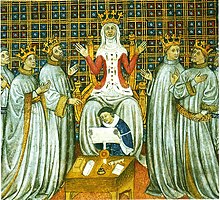Clotilde
Saint Clotilde | |
|---|---|
Pre-Congregation | |
| Feast | June 3 (June 4 in France) |
| Attributes | wearing a crown and holding a church; with a battle in the background, in memory of the Battle of Tolbiac. |
| Patronage | brides, adopted children, parents, exiles, notaries, widows, the lame |
Clotilde (c. 474 – 3 June 545),
Venerated as a
Biography

Clotilde was born at the Burgundian court of Lyon, the daughter of King Chilperic II of Burgundy. Upon the death of Chilperic's father King Gondioc in 473, Chilperic and his brothers Gundobad and Godegisel divided their inheritance; Chilperic II apparently reigning at Lyon, Gundobad at Vienne, and Godegesil at Geneva.[2]
From the sixth century on, the marriage of Clovis and Clotilde was made the theme of epic narratives, in which the original facts were materially altered and the various versions found their way into the works of different Frankish chroniclers.
After the death of Chilperic, her mother seems to have made her home with Godegisil at Geneva, where her other daughter, Chrona, founded the church of Saint-Victor. Soon after the death of Chilperic in 493, Clovis asked and obtained the hand of Clotilde.[2] They were married in 493.
The marriage produced the following children:
- Ingomer (born and died 494).
- Chlodomer (495–524), King of the Franks at Orléans from 511.
- Childebert I (496–558), King of the Franks at Paris from 511.
- Chlothar I (497–561), King of the Franks at Soissons from 511, King of all Franks from 558.
- Clotilde (500–531), married Amalaric, King of the Visigoths.
Clotilde was brought up as a Christian and did not rest until her husband had abjured paganism and embraced Christianity. According to Gregory of Tours' Historia Francorum (History of the Franks), when Clotilde had their first child baptised, he died soon after. Clovis upbraided her; but when Chlodomer was born, she insisted on baptising him also. Although Chlodomer did indeed fall ill, he soon after recovered. More healthy children followed.[9]
Clotilde's victory came in 496, when Clovis converted to Christianity, baptised by Bishop
Historical significance
Unusually, Clotilde was a
Later years

After Clovis' death in 511, Clotilde retired to the
In 523 Clotilde's sons went to war against her cousin King
After these failures, Clotilde appeared to dedicate herself to a saintly life. She occupied herself with the building of churches and monasteries, preferring to distance herself from the power struggles of the court.[11] Churches associated with her are located at Laon and Rouen.
On 3 June 545, Clotilde died at the tomb of St. Martin of
Veneration
Clotilde's veneration made her the patron of queens, widows, brides and exiles. In
Clotilde is the patron saint of Les Andelys, Normandy. In 511, the Queen founded a convent for young girls of the nobility there, which was destroyed by the Normans in 911. In its place was erected Our Lady's Collegiate Church, which contains a statue of Saint Clotilde. Also in Les Andelys is Saint Clotilde's Fountain, popularly believed to heal skin diseases.[12]
See also
- List of Catholic saints
- List of Frankish queens
References
- ^ The Encyclopedia of Saints: "Clotilde was born at Lyons, France, about 474, the daughter of King Chilperic of Burgundy. She married the Salian Frankish king Clovis I in 493, who used their alliance as a means of strengthening his position with the Romanized Celts".
- ^ a b c d Kurth, Godefroid. "St. Clotilda". The Catholic Encyclopedia. Vol. 4. New York: Robert Appleton Company, 1908. Retrieved 19 July 2014.
- ^ Gregory of Tours, Historia Francorum, "Now the king of the Burgundians was Gundevech, of the family of king Athanaric the persecutor, whom we have mentioned before."
- ^
ISBN 9781317871163. Retrieved 16 March 2019.
- ^ a b
Online, Catholic. "St. Clotilde – Saints & Angels – Catholic Online". Catholic Online. Retrieved 29 November 2017.
St. Clotilde (c. 474- 545) and her husband King Clovis (c. 466-511) founded the Merovingian dynasty, which ruled the Franks for over 200 years. [...] She died at the tomb of St. Martin of Tours and was buried in Sainte-Genevieve in Paris [...].
- ^ Britannica, Encyclopaedia. "St. Clotilda". Encyclopaedia Britannica. Retrieved 16 July 2019.
- ^ a b c One or more of the preceding sentences incorporates text from a publication now in the public domain: Pfister, Christian (1911). "Clotilda, Saint". In Chisholm, Hugh (ed.). Encyclopædia Britannica. Vol. 6 (11th ed.). Cambridge University Press. p. 557.
- ^ Butler, Alban. The Lives or the Fathers, Martyrs and Other Principal Saints, Vol. VI, D. & J. Sadlier, & Company, 1864
- ^ ISBN 9780192800589.
- ^ Asimov, Isaac (1968) The Dark Ages, Boston: Houghton Mifflin, pp. 55–56
- ^ "Saint Clotilda". Saints.SQPN.com. 21 May 2009. Retrieved 13 July 2012.
- ^ ""Saint Clotilde's Fountain", Office Municipal de Tourisme des Andelys". Archived from the original on 1 April 2015. Retrieved 19 July 2014.
